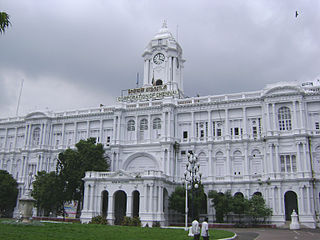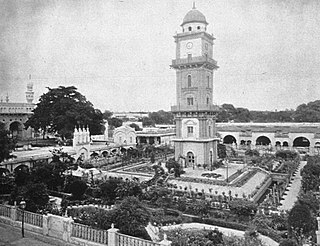Related Research Articles

Mirzapur is a city in Uttar Pradesh, India, 827 km from Delhi and 733 km from Kolkata, almost 91 km from Prayagraj and 61 km from Varanasi. It is known for its carpets and brassware industries, and the tradition of kajari and birha music. The city is surrounded by several hills of the Maikal range and is the headquarters of Mirzapur district.

Faizabad is a city located in Ayodhya district in the Indian state of Uttar Pradesh. It is situated on the southern bank of the River Saryu about 6.5 km from Ayodhya City, the district headquarter, 130 km east of the state capital Lucknow. Faizabad was the first capital of the Nawabs of Awadh and has monuments built by those Nawabs, like the Tomb of Bahu Begum, Gulab Bari. It was also the headquarters of Faizabad district and Faizabad division before November 2018. Faizabad is a twin city of Ayodhya and it is administered by Ayodhya Municipal Corporation.

The Paradesi Synagogue aka Cochin Jewish Synagogue or the Mattancherry Synagogue is a synagogue located in Mattancherry Jew Town, a suburb of the city of Kochi, Kerala, in India. It was built in 1568 A.D. by Samuel Castiel, David Belila, and Joseph Levi for the flourishing Paradesi Jewish community in Kochi. Cochin Jews were composed mainly of the much older Malabari Jews and the newly arrived Sephardic refugees from the Portuguese religious persecution of Jews in Spain and Portugal. It is the oldest active synagogue in the Commonwealth of Nations. Paradesi is a word used in several Indian languages, and the literal meaning of the term is "foreigners", applied to the synagogue because it was built by Sephardic or Portuguese-speaking Jews, some of them from families exiled in Aleppo, Safed and other West Asian localities.

Old Delhi is an area in the Central Delhi district of Delhi, India. It was founded as a walled city and officially named Shahjahanabad in 1648, when Shah Jahan decided to shift the Mughal capital from Agra. The construction of the city was completed in 1648, and it remained the capital of Mughal India until its fall in 1857, when the British Empire took over as paramount power in the Indian subcontinent.

Shri Digambar Jain Lal Mandir is the oldest and best-known Jain temple in Delhi, India. It is directly across from the Red Fort in the historical Chandni Chowk area.

Prayagraj Airport, also known as Allahabad Airport, is the domestic airport serving the city of Prayagraj, Uttar Pradesh, India. Located in the Bamrauli suburb of the city, it is one of the oldest airports in India. This airport is currently under joint operation of the Indian Air Force and the Airports Authority of India. It is the third busiest airport in Uttar Pradesh after Lucknow International Airport and Varanasi International Airport in terms of passenger traffic and aircraft movements.

The Ripon Building is the seat and headquarters of the Greater Chennai Corporation in Chennai, Tamil Nadu. It is an example of neoclassical architecture, a combination of Ionic and Corinthian styles. The Ripon Building is an all-white structure and is located near the Chennai Central railway station.
Chowk is a neighborhood in Prayagraj, Uttar Pradesh, India. It is the historic city centre of Old Prayagraj. It is one of the oldest & largest business markets of India & lies in old Prayagraj. The landmark of this market is historic Prayagraj Clock Tower, built in 1913, also known as Chowk Ghantaghar.
The Old Prayagraj City, at the south of Prayagraj Junction Railway Station, consists of neighborhoods like Chowk, Johnstongunj, Dariyabad, Khuldabad etc. and was in existence from the time of Akbar. Some magnificent structures erected in this era consist of the Khusro Bagh and the Allahabad Fort. In the north of Railway Station, the New Prayagraj City consists of neighborhoods like Lukergunj, Civil Lines, Georgetown, Tagoretown, Bharadwaj Puram, Ashok Nagar, Mumfordgunj etc., which are relatively new and were built during the British rule. These neighborhoods reflect British architecture like the All Saints Cathedral, Alfred Park and Allahabad High Court. Newer residential areas include neighborhoods like Kareli and suburbs like Naini Jhunsi and Manauri bajar.

Prayagraj, formerly known as Allahabad or Ilahabad, is a metropolis in the Indian state of Uttar Pradesh. It is the administrative headquarters of the Prayagraj district, the most populous district in the state and 13th most populous district in India and the Prayagraj division. The city is the judicial capital of Uttar Pradesh with the Allahabad High Court being the highest judicial body in the state. As of 2011, Prayagraj is the seventh most populous city in the state, thirteenth in Northern India and thirty-sixth in India, with an estimated population of 1.53 million in the city. In 2011, it was ranked the world's 40th fastest-growing city. The city, in 2016, was also ranked the third most liveable urban agglomeration in the state and sixteenth in the country. Hindi is the most widely spoken language in the city.

Delhi Junctionrailway station is the oldest railway station in Old Delhi, Delhi, India. It is one of the busiest railway stations in India in terms of frequency. Around 250 trains start, end, or pass through the station daily. It was established near Chandni Chowk in 1864 when trains from Howrah, Calcutta started operating up to Delhi. Its present building was constructed by the British Indian government in the style of the nearby Red Fort and opened in 1903. It has been an important railway station of the country and preceded the New Delhi by about 60 years. Chandni Chowk station of the Delhi Metro is located near it.

His Excellency Amir e Paigah Basheerd-Ud-daula Azam-Ul-Umra Amir-e-Akbar Nawab Sir Muhammad Mazharuddin Khan Bahadur Rifa’at Jang, commonly known as Sir Asman Jah or Nawab Sir Asman Jah Bahadur, Asman Jah was one of those fortunate individuals to whom it has been given by fate to write their names large in the annals of their country, he was an Indian noble and member of the Great Paigah Family who served as Prime Minister of Hyderabad from 1887 to 1894. As the grandson of the premier noble Fakhr Uddin Khan Amir e Kabir Shams-ul-Umra I and of a princess of the blood, his social position was a great one; but the personal qualities he possessed, inherited largely from his grandfather, were unquestionably the means of bringing him to the front. Singularly gifted by nature as far as the outward man was concerned and excelling in all manly pursuits, he easily took the lead among his peers. But it was his mental and moral equipment which attracted the notice of his royal master while yet the young noble was in early manhood. Such was the promise he showed that His Highness the Afzal-ud-Daulah gave him his daughter in marriage and bestowed on him the highest distinction in his gift, the title of Jah.in 1869, Asman Jah entered on his public career as Minister of Justice. A little later on, while still retaining the portfolio of Justice, he acted as Prime Minister and co-regent. Later still he became a Member of the Council of Regency, and finally in 1887 he was appointed Prime Minister and continued to hold the office till 1893. In this connection it may be noted that throughout his long official career, Sir Asman Jah refused to take any salary while willing to take office he steadily persisted im refusing the emoluments of office. Elis regime as Premier was marked by several reforms, notably the advance made in education, the extension of medical aid by the State, especially aid to women, and the establishment of a permanent Board of Irrigation and city water supply, which has since been of excellent service to the State, Asman Jah was still in London when he got the news of his having been-appointed Prime Minister and one of the first to congratulate him on his appointment was his late Majesty King Edward VIL, then Prince of Wales, Asman Jah built several architectures throughout the city like Asman Garh Palace, Basheer Bagh Palace, saroonagar palace and Mahboob Chowk Clock Tower. Just before he was appointed to the premiership he was deputed by His Highness the late Nizam, Mahboob Ali Khan, to proceed in 1887 to London as his representative at the Golden Jubilee of Her late Majesty Queen Victoria. While in England he won golden opinions by the tact, savoir faire and high breeding he displayed His handsome presence, imposing address and polished manners impressed all classes of English Society and he became a great favourite in court circles. Indeed, the late Nizam could not have had a more dignified or worthier representative.

Situated in the northern part of India, bordering with the capital of India New Delhi, Uttar Pradesh is one of the most popular and an established tourist destination for both Indians and non-Indians alike in India. The most populous state of India, Uttar Pradesh contains many historical monuments and places of religious significance. Geographically, Uttar Pradesh is very diverse, with Himalayan foothills in the extreme north and the Gangetic Plain in the centre. It is also home of India's most visited sites, Hinduism's holiest city, Varanasi. Kumbh city, Prayagraj. Kathak, one of the eight forms of Indian classical dances, originated from Uttar Pradesh. Uttar Pradesh is at the heart of India, hence it is also known as The Heartland of India. Cuisine of Uttar Pradesh like Awadhi cuisine, Mughlai cuisine and Bhojpuri cuisine are very famous not only in India but also many places abroad.

Lal Chowk is a city square in Srinagar, in the Indian union territory of Jammu and Kashmir.
Smith of Derby Group is a clockmaker based in Derby, England founded in 1856. Smith of Derby has been operated continuously under five generations of the Smith family.
This is a timeline of the history of the city of Prayagraj, Uttar Pradesh, India.

Ghantaghar is a location in the center of Chandni Chowk, Delhi, where an iconic clock tower, termed Northbrook Clocktower during early 20th century, stood. The clock tower was built in 1870 and stood there until its partial collapse and subsequent demolition in 1950s. The term "Chandni Chowk" originally referred to this location which later came to designate the entire street. The Ghantaghar location has been regarded as the center of Delhi, and even now serves as a center for major civic events. Today, it is an open and congested area. The Delhi Town Hall is located just to the north of this site.

Mahboob Chowk Clock Tower is a five-storied architectural clock tower which was built in 1892 by Asman Jah, Prime Minister of Hyderabad. Named after the 6th Nizam of Hyderabad -, the Mahboob Chowk area is considered to be an important part architectural heritage of Hyderabad.
References
- ↑ Singh, Dr Yatindra Pal (2021). "43. Prayagraj". Clock towers of India. Blue Rose Publishers. p. 104. ISBN 978-9-35427-256-1.
- ↑ Ashutosh Joshi (1 January 2008). Town Planning Regeneration of Cities. New India Publishing. p. 121. ISBN 978-8189422820.